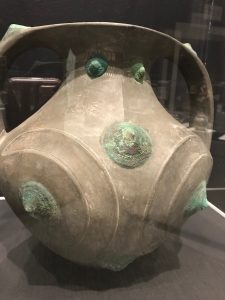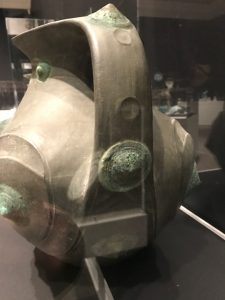 This piece is called Sichuan Lifan Amphora and is apart of the Color across Asia display. It is from the Chinese, Eastern Han dynasty from 25 CE- 22- CE and is black earthenware with incised and burnished decor and bronze appliques. An amphora like this one are very unique in the Chinese history of ceramics. Amphoras similar to this piece are called lifan, and their forms and decoration vary and are so different and distinct compared to other forms of pottery. Also, they are rarely ever on display.
This piece is called Sichuan Lifan Amphora and is apart of the Color across Asia display. It is from the Chinese, Eastern Han dynasty from 25 CE- 22- CE and is black earthenware with incised and burnished decor and bronze appliques. An amphora like this one are very unique in the Chinese history of ceramics. Amphoras similar to this piece are called lifan, and their forms and decoration vary and are so different and distinct compared to other forms of pottery. Also, they are rarely ever on display.
What first drew me to this piece was the teal color. Granted it looks faded and is faded in some areas but the color still stands out, especially being on the black. The whole outside of the piece is the charred, faded, ashy looking black-it kind of reminds me of metal at a quick glance and from far away, but still looks rough. With the exception of the top part of the neck, the inside of this piece is a brownish, tan color. The outside of the neck has 3 rows of these lines or tick marks each having a longer horizontal line separating each row. Over many parts of the body you can see some bronze color and these knob, circular looking objects. They stick out slightly on the piece and seem to have a light point on their end. The teal part of the circles have a little design on them as well. There are tiny circles going all around the teal part of the circle. The bronze appears more on the tip and outer part of these circle shapes. The object itself seems to be made with clean lines but the designs on it aren’t as clean looking when it comes to the lines and circles drawn on it- they still look nice but it isn’t perfect. The handles of this have more circles on it, some being the teal ones and then a couple of others that are more drawn into the piece and what seems like dented into it at first.
 Just from looking at this amphora, I couldn’t guess its use or function. To me I just see a vase. A vase that is just decorative. However, it doesn’t look as smooth or “round” as most vases I’ve seen do. This one seems more boxy or shapey to me. I think that’s another reason why it stood out to me. I wanted to know more about this piece and after walking around the gallery I found the artifact guide. After reading it, some of my questions were answered and it was interesting to compare the guide to what I took from the piece itself. What the guide said about the piece and its forms and its potential use was, “The geometric forms may have been designed to recall metalware; the sixteen studs decorating the surface show traces of think bronze overlay, which would have shone brightly against the black surface of the vessel. The studs at the center of the circular designs on the belly resemble eyes. The practical, sturdy handles suggest that this amphora was used in everyday life, perhaps as a pouring vessel for fine grains. Seeing how some of my thoughts matched up was comforting but I was also very interested and surprised to learn about the studs being eyes. I would have never guessed that. I can also now see this being used functionally and knowing that and looking back at it, I could understand why it was used with how thick and strong it seems to be. Knowing that the gallery this piece is in is about the changes and differences of shared traditions, techniques, and materials, I can really understand how this piece fits into it and have more of an appreciation for it. Throughout the whole gallery you can see the changes of color and materials used and how there are similarities to many with their form or use or whatever it may be, and then there are pieces like this that vary in form and material and its color looks different. You can really see history in this gallery and how it influenced the artifacts.
Just from looking at this amphora, I couldn’t guess its use or function. To me I just see a vase. A vase that is just decorative. However, it doesn’t look as smooth or “round” as most vases I’ve seen do. This one seems more boxy or shapey to me. I think that’s another reason why it stood out to me. I wanted to know more about this piece and after walking around the gallery I found the artifact guide. After reading it, some of my questions were answered and it was interesting to compare the guide to what I took from the piece itself. What the guide said about the piece and its forms and its potential use was, “The geometric forms may have been designed to recall metalware; the sixteen studs decorating the surface show traces of think bronze overlay, which would have shone brightly against the black surface of the vessel. The studs at the center of the circular designs on the belly resemble eyes. The practical, sturdy handles suggest that this amphora was used in everyday life, perhaps as a pouring vessel for fine grains. Seeing how some of my thoughts matched up was comforting but I was also very interested and surprised to learn about the studs being eyes. I would have never guessed that. I can also now see this being used functionally and knowing that and looking back at it, I could understand why it was used with how thick and strong it seems to be. Knowing that the gallery this piece is in is about the changes and differences of shared traditions, techniques, and materials, I can really understand how this piece fits into it and have more of an appreciation for it. Throughout the whole gallery you can see the changes of color and materials used and how there are similarities to many with their form or use or whatever it may be, and then there are pieces like this that vary in form and material and its color looks different. You can really see history in this gallery and how it influenced the artifacts.